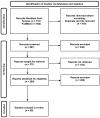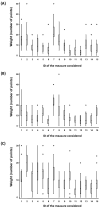Systematic Review of the Key Factors Influencing the Indoor Airborne Spread of SARS-CoV-2
- PMID: 36986304
- PMCID: PMC10053454
- DOI: 10.3390/pathogens12030382
Systematic Review of the Key Factors Influencing the Indoor Airborne Spread of SARS-CoV-2
Abstract
The COVID-19 pandemic due to the Severe Acute Respiratory Syndrome Coronavirus 2 (SARS-CoV-2) has been plaguing the world since late 2019/early 2020 and has changed the way we function as a society, halting both economic and social activities worldwide. Classrooms, offices, restaurants, public transport, and other enclosed spaces that typically gather large groups of people indoors, and are considered focal points for the spread of the virus. For society to be able to go "back to normal", it is crucial to keep these places open and functioning. An understanding of the transmission modes occurring in these contexts is essential to set up effective infection control strategies. This understanding was made using a systematic review, according to the Preferred Reporting Items for Systematic reviews and Meta-Analyses statement (PRISMA) 2020 guidelines. We analyze the different parameters influencing airborne transmission indoors, the mathematical models proposed to understand it, and discuss how we can act on these parameters. Methods to judge infection risks through the analysis of the indoor air quality are described. Various mitigation measures are listed, and their efficiency, feasibility, and acceptability are ranked by a panel of experts in the field. Thus, effective ventilation procedures controlled by CO2-monitoring, continued mask wearing, and a strategic control of room occupancy, among other measures, are put forth to enable a safe return to these essential places.
Keywords: CO2; COVID-19; SARS-CoV-2; air quality; airborne transmission; indoor; mitigation measures.
Conflict of interest statement
The authors declare no conflict of interest.
Figures



References
-
- WHO World Health Organization—Convened Global Study of Origins of SARS-CoV-2: China Part. Joint WHO-China Study (14 January–10 February 2021) 2021. [(accessed on 16 April 2022)]. Available online: https://www.who.int/publications/i/item/who-convened-global-study-of-ori....
-
- WHO World Health Organization Coronavirus (COVID-19) Dashboard. WHO Coronavirus (COVID-19) Dashboard with Vaccination Data. 2022. [(accessed on 1 October 2022)]. Available online: https://covid19.who.int/
Publication types
Grants and funding
LinkOut - more resources
Full Text Sources
Miscellaneous

